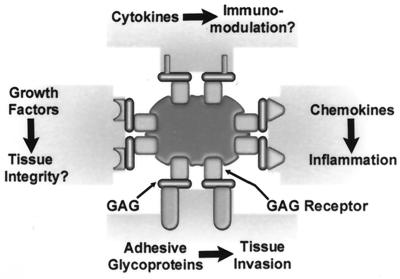FIG. 5.
Proposed model for heparin-mediated recruitment of mammalian proteins. Microbes (pictured in the center) with heparin binding activities bind heparin and functionally related glycosaminoglycans (GAG) from the environment through species-specific bacterial glycosaminoglycan receptors. The glycosaminoglycans bound at the bacterial cell surface subsequently serve as universal binding sites for theoretically any mammalian heparin binding protein present in the environment, including adhesive glycoproteins, chemokines, growth factors, and cytokines. The repertoire of surface-bound proteins may affect various aspects of microbial virulence and host defense systems, such as chemotaxis, tissue invasion, tissue integrity, and immunological responses.

